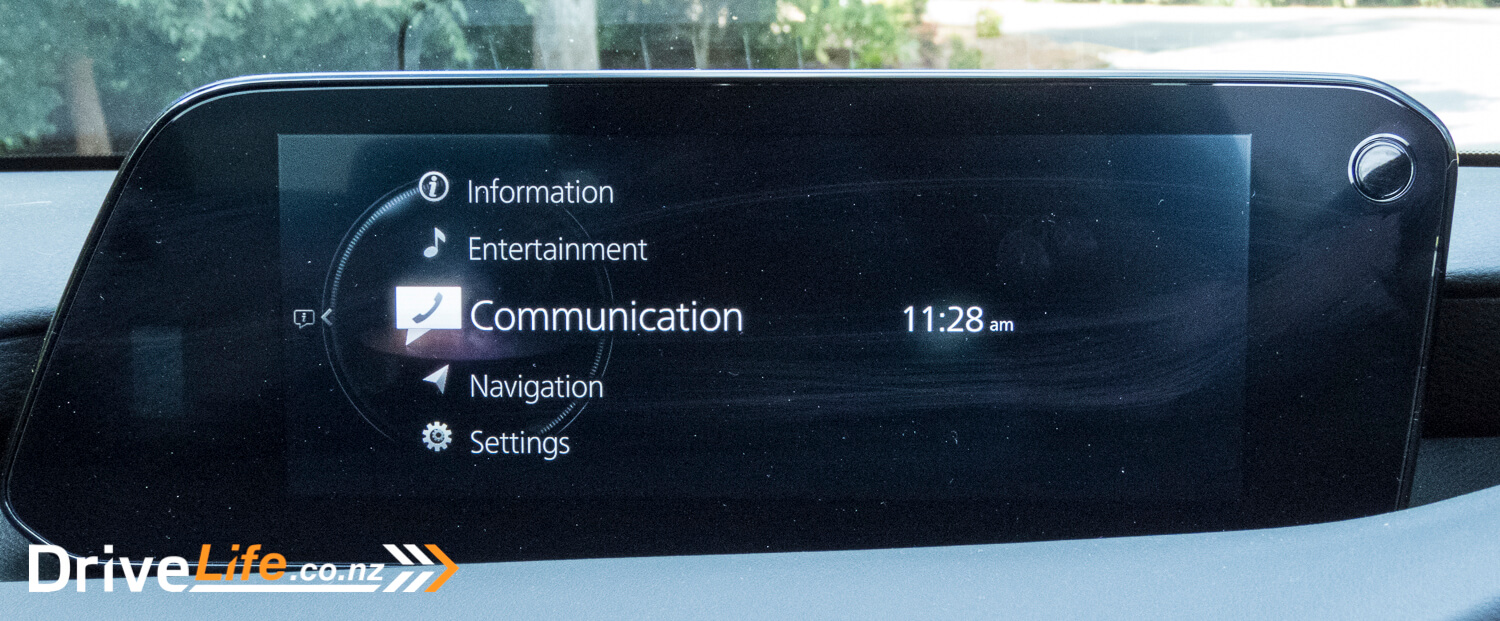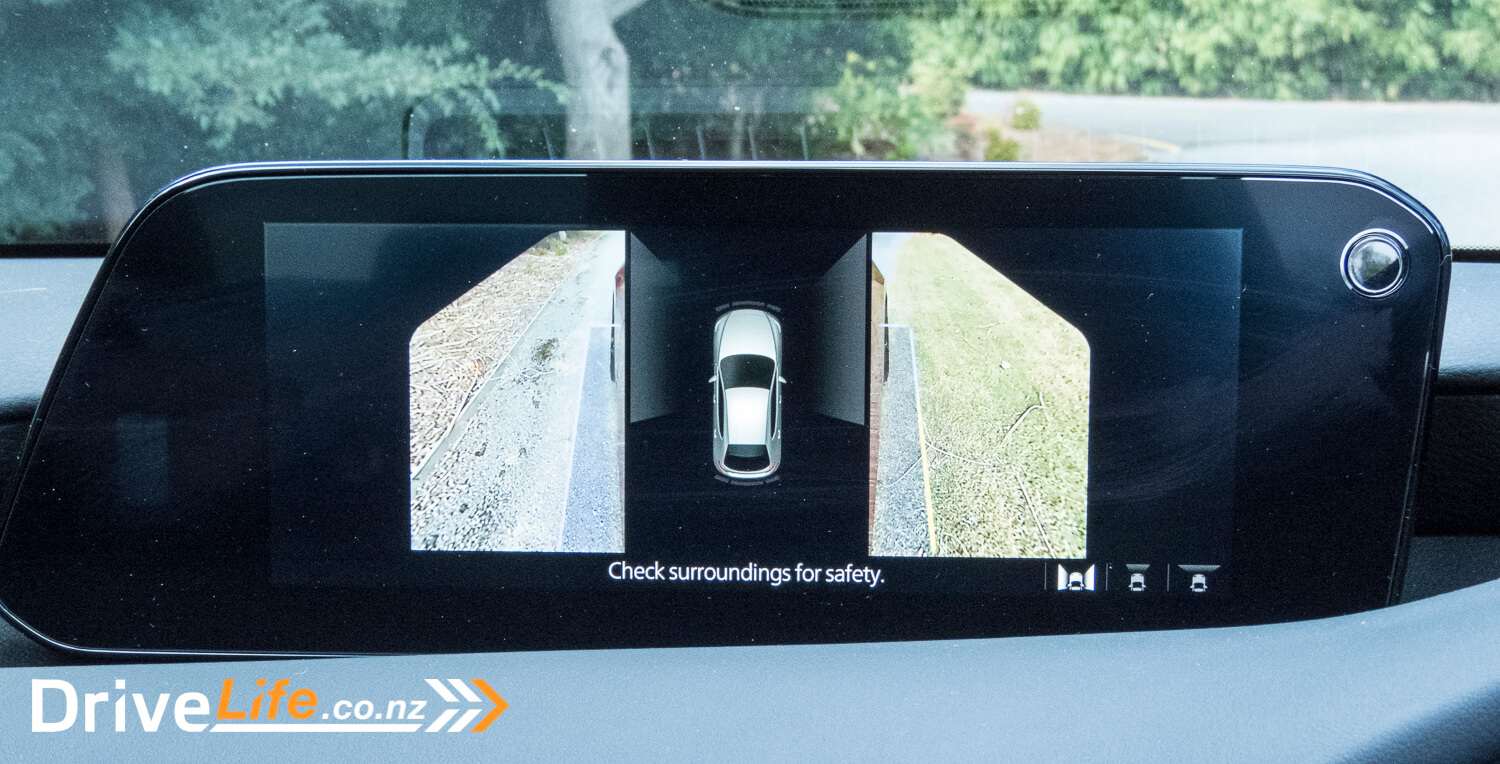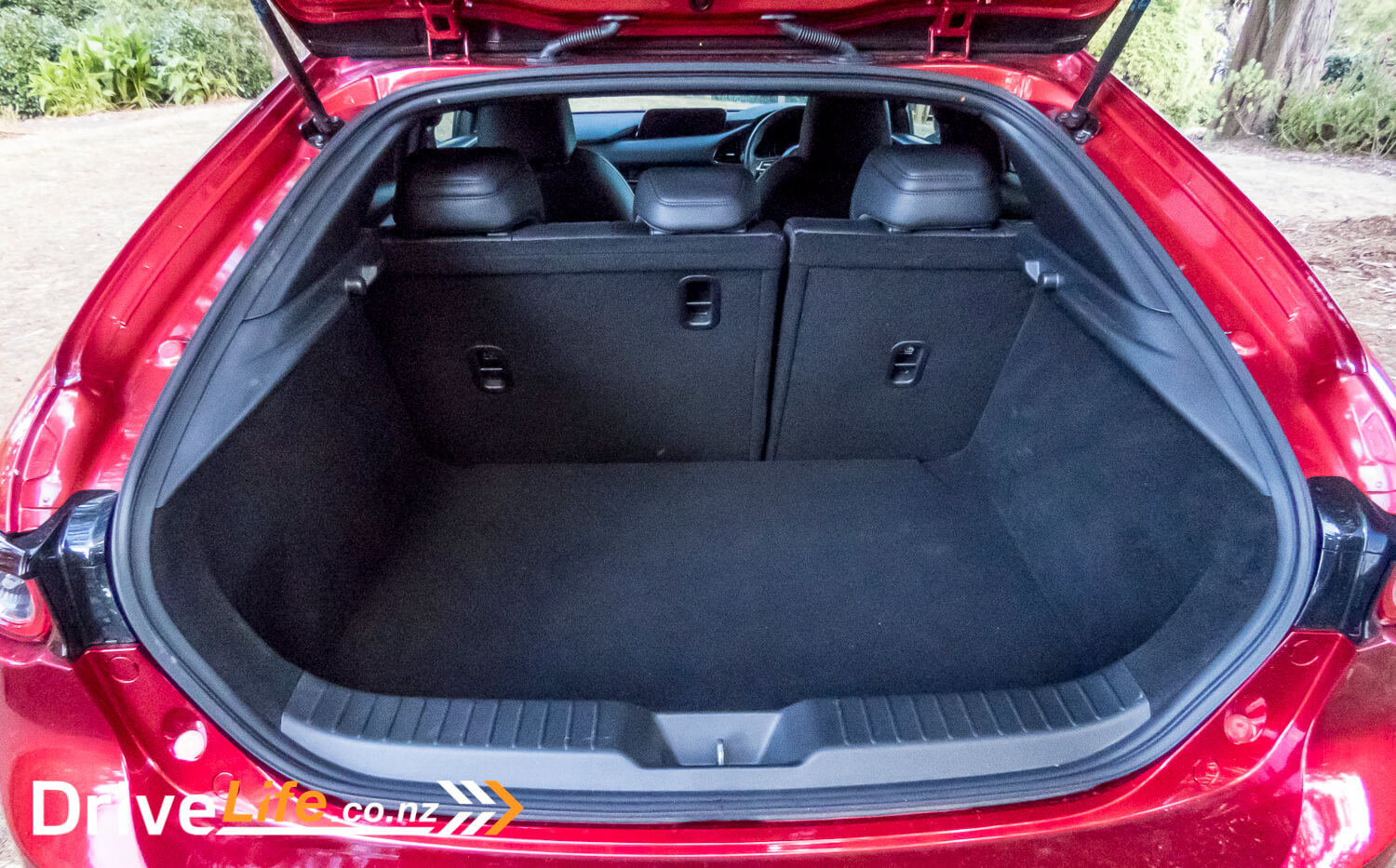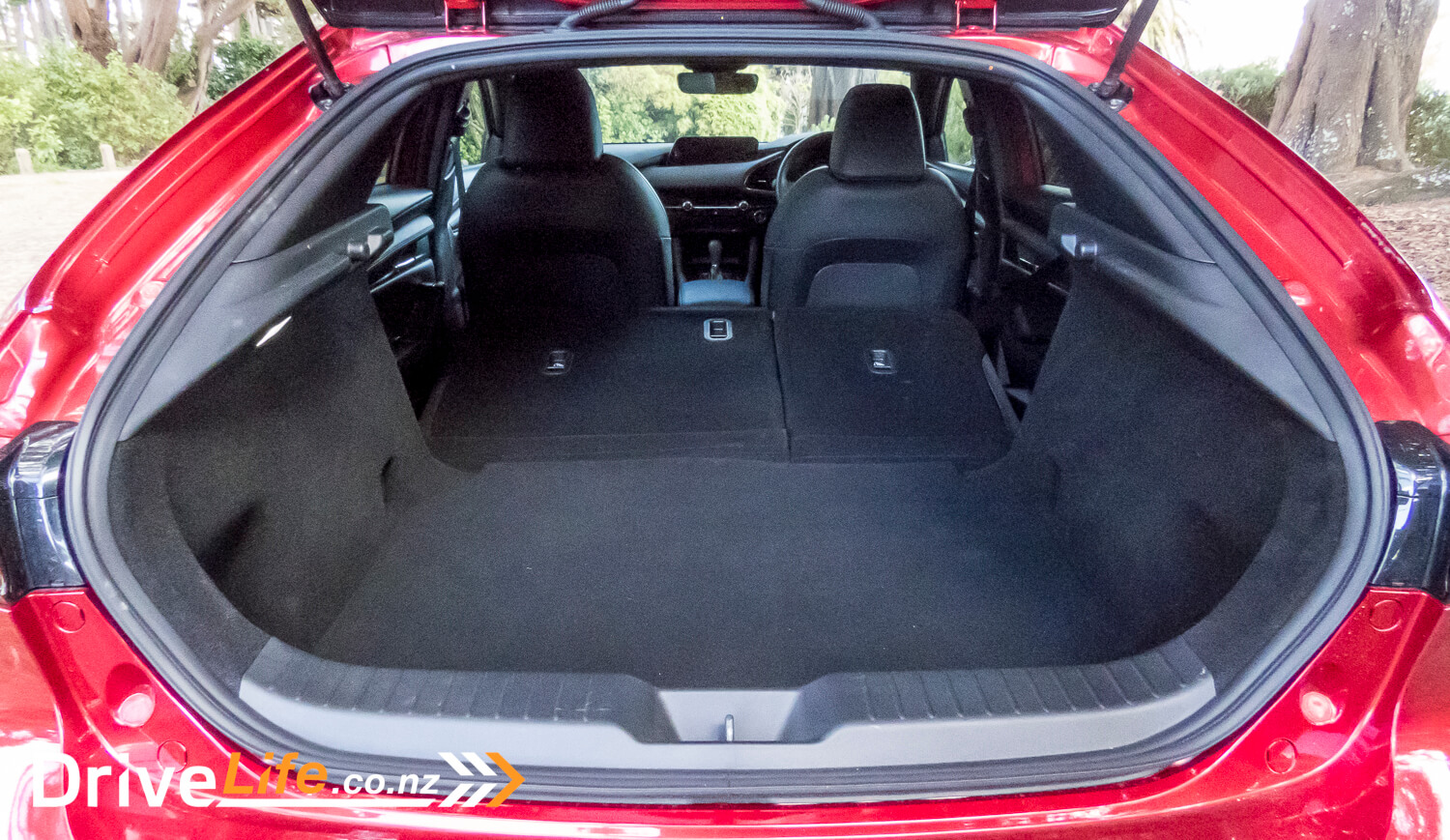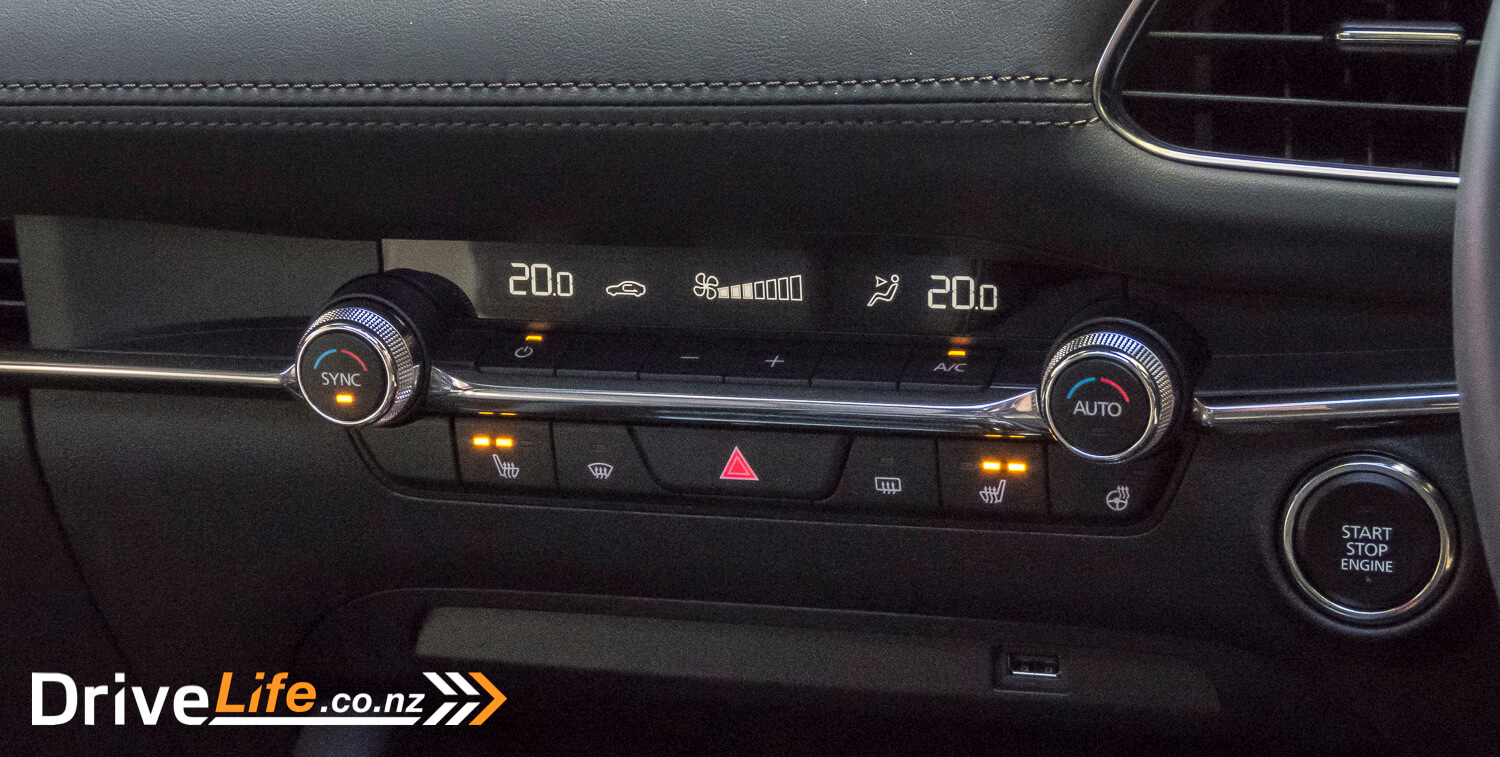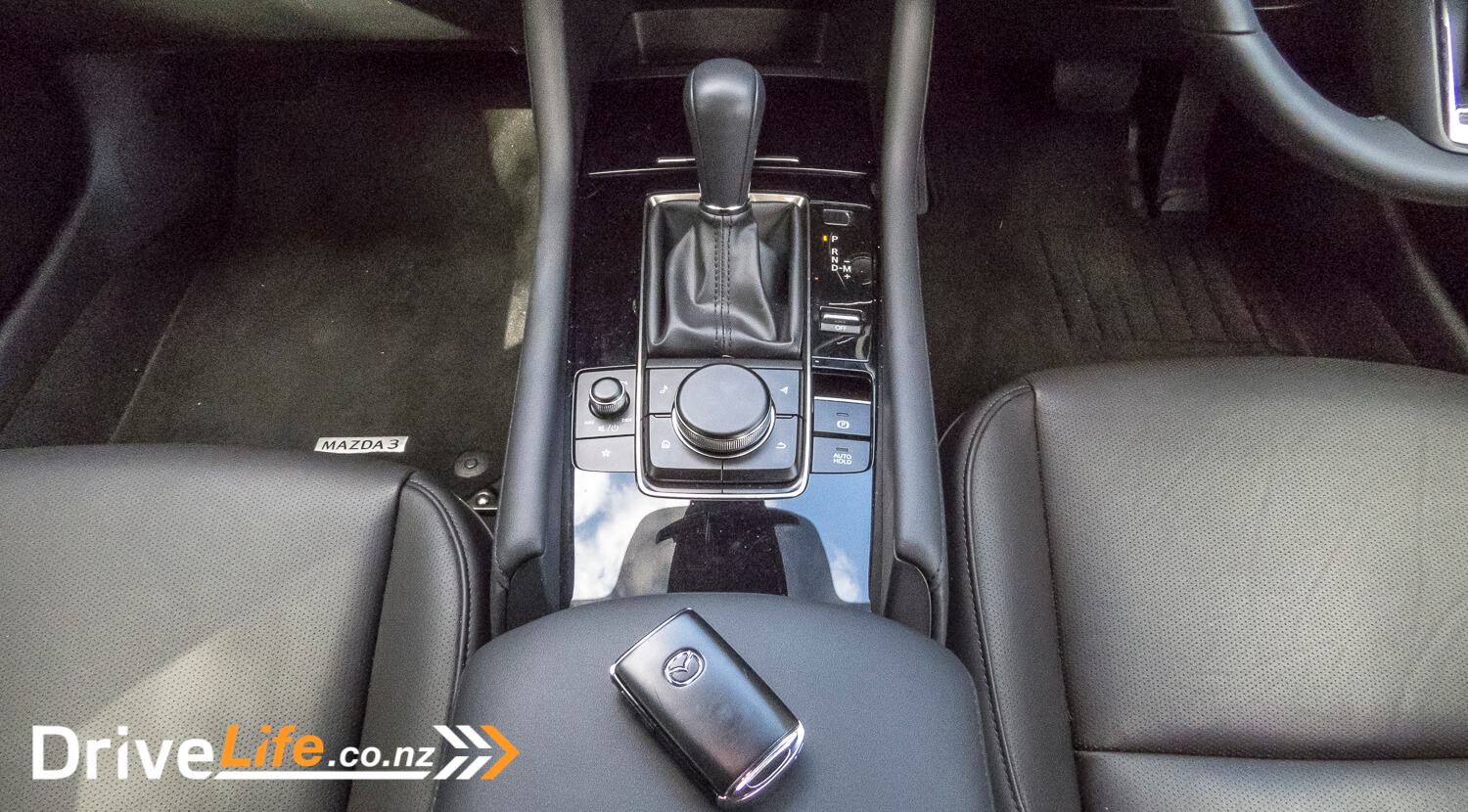Most crossovers trawl the depths of my indifference. In reality, many of them are hatchback-derived vehicles – lifted a few inches, adorned with plastic body cladding, and marketed to yuppies as a practical adventure vehicle.
In reality, crossovers are often more expensive than their hatchback siblings, and those buyers who feature prominently in the marketing bumphs never have time to get away on the weekend.
Personally, I think much of the crossover buying population would be better off buying a hatchback. Currently, the hatchback segment features some of the best value and more interesting main market vehicles you can buy. This has never been truer than with the current Mazda3.
Mazda has really upped their game with the quality of their vehicles lately. I was blown away by how good the CX-30 was, thus I was genuinely keen to test out the Mazda3.
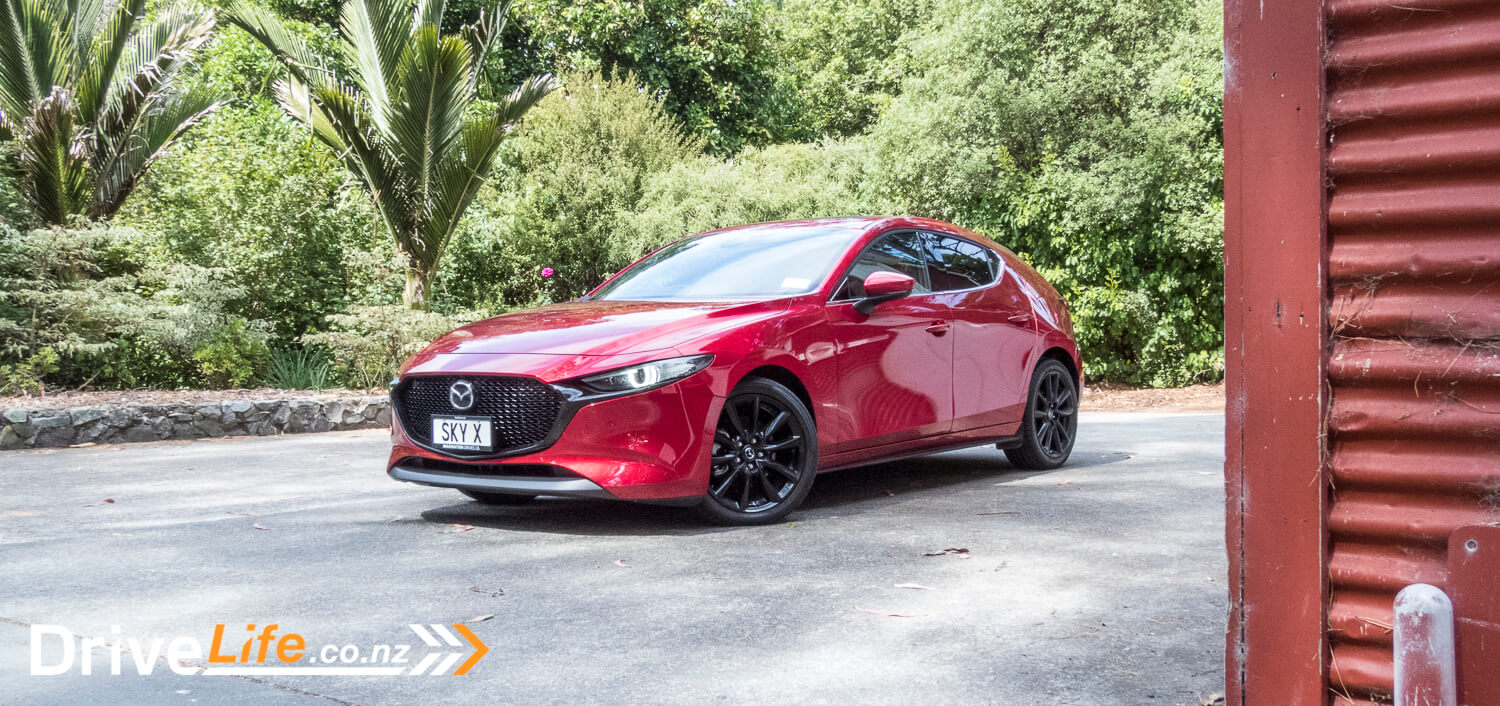
What’s In The 2021 Mazda3 Range?
The Mazda3 is offered with four different trim levels, configured as either a hatchback or sedan. These are priced below:
| Hatchback | GSX | $36,895 |
| GTX | $41,095 | |
| Limited | $48,795 | |
| Takami | $51,995 | |
| Sedan | GSX | $36,595 |
| GTX | $41,095 | |
| Limited | $48,795 |
GSX
Base trim starts with the GSX, which is offered with Mazda’s 2-litre 4-cylinder SkyActiv-G engine, producing 114kW of power and 200Nm of torque. Combined fuel economy is a claimed 6.2L/100kms. The engine is paired with a 6-speed automatic gearbox.
The GSX is offered with plenty of standard features, including 16’’ alloys, an 8.8’’ infotainment with Apple Carplay and Android Auto, satnav, 8-speaker audio, heads-up display, auto LED headlamps, LED taillights, push button start, cloth seats, rear parking sensors and rain sensing wipers.
GTX
Move up to the GTX, you gain a larger 2.5-litre 4-cylinder SkyActiv-G engine, producing 139kW of power and 252Nm of torque. This engine features cylinder deactivation, and combined economy is a claimed 6.6L/100kms. The same 6-speed automatic gearbox is used as on the GSX.
The GTX gains 18’’ alloys, keyless entry, front parking sensors, an auto dimming rear-view mirror, dual zone climate control, heated mirrors with vanity illumination and plus Smart Brake Support extends to the rear and for rear cross traffic.
Limited
The Limited uses the same engine and gearbox as the GTX, with all the same performance figures.
On the feature front, the Limited adds heated leather seats, 10-power adjustable driver’s seat, Bose 12 speaker audio, adaptive LED headlights, LED daytime running lights, rear LED light signature, auto-dimming exterior mirrors with position memory and reverse gear tilt-down function, sunroof, privacy glass, plus Cruising & Traffic Support (CTS), Front Cross Traffic Alert (FCTA) and driver monitoring.
Takami
The Takami is the big cheese of the range, and it’s only offered in hatchback form. It gains Mazda’s new 2-litre 4-cylinder SkyActiv-X engine with mild-hybrid technology. This engine utilises a process called Spark Controlled Compression Ignition (SPCCI) to offer better performance and few emissions. The SkyActiv-X engine produces 132kW of power, 224Nm of torque and has a combined fuel consumption of 5.5L/100kms. The engine is paired with a slightly different 6-speed automatic, specific to the Skyactiv-X (called Skyactiv-Drive). We’ll talk about this further in The Drive section of the review.
The Takami also adds a heated steering wheel, four cameras with front, rear and 360o views plus dynamic guidelines. You also get a few aesthetic upgrades including black 18’’ alloys, bigger exhaust tips, a frameless rear-view mirror plus you can choose from black or burgundy leather colours for the interior.

All models of Mazda3 are equipped with i-ActivSense safety tech suite, which gives you many acronyms.
These include; Adaptive Cruise Control (MRCC), Blind Spot Monitoring (BSM) , Driver Attention Alert (DAA), Forward Obstruction Warning (FOW), High Beam Control (HBC), Lane Departure Warning (LDW), Lane-keep Assist System (LKA), Rear Cross Traffic Alert (RCTA), Secondary Collision Reduction (SCR), Smart Brake Support (SBS) with night time cyclist and pedestrian protection, Traffic Sign Recognition (TSR) and Tyre Pressure Monitoring System (TPMS).
The Mazda3 is offered with 8 different colour options; 4 Mica colours and 4 Metallic colours. These are; Deep Crystal Blue, Jet Black, Snowflake White, Titanium Flash (bronze grey), Polymetal Grey (blue-grey), Machine Grey (deep grey), Sonic Silver and Soul Red Crystal Metallic.
For more information on the Mazda 3, visit the Mazda New Zealand website.
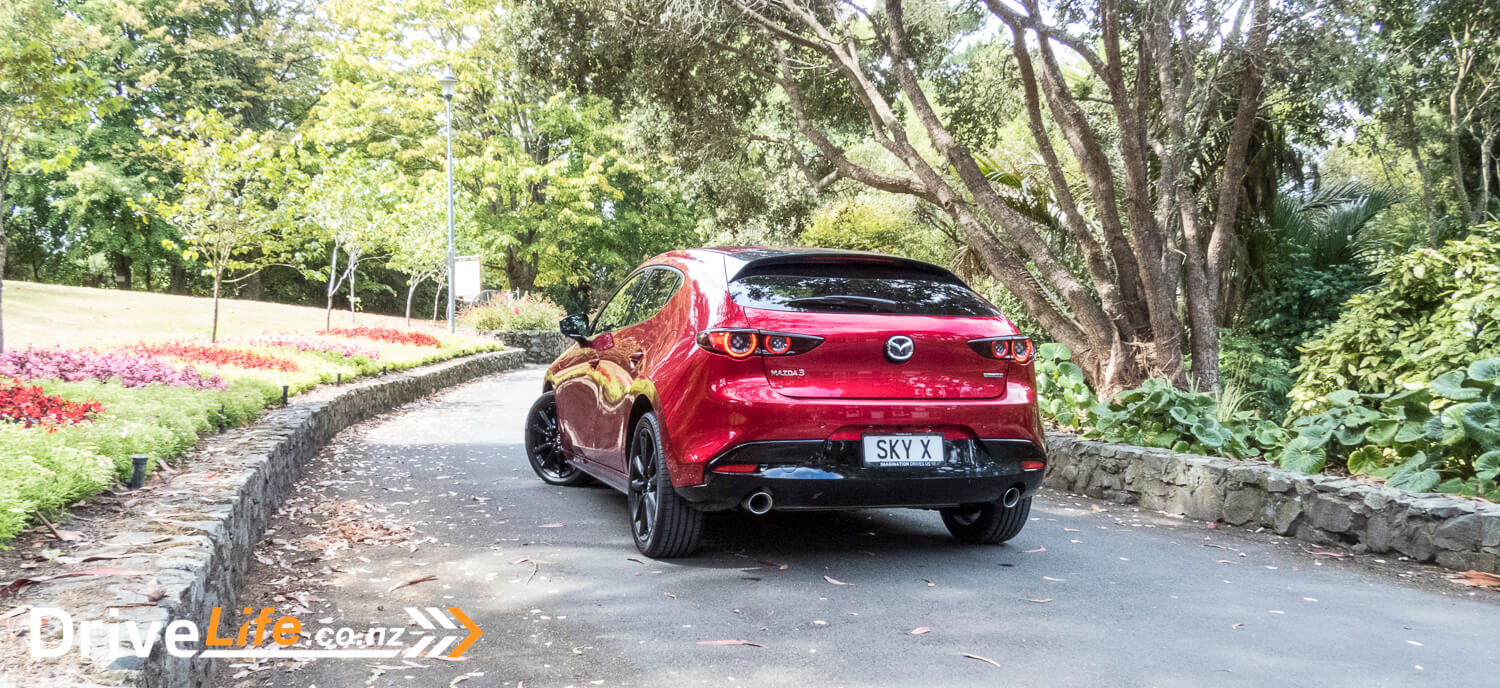
First Impressions Of The 2021 Mazda3 Takami
Mazda is in a hot spot with their designs at the moment, and this Mazda 3 is easily one of the best yet.
The shape of this Mazda3 gives me an Alfa Romeo vibe, and by all metrics in the car world, that’s a good thing.
Although the body shape imitates an Alfa, the bodylines are distinctively Mazda. As opposed to sharp lines and creases, there’s a fluidity to the design which is a hallmark of Mazda’s Kodo design language. The C-pillar design also makes the body look more shooting brake than hatchback, plus the rear LEDs again remind me of an Alfa, specifically the Giulietta hatch.
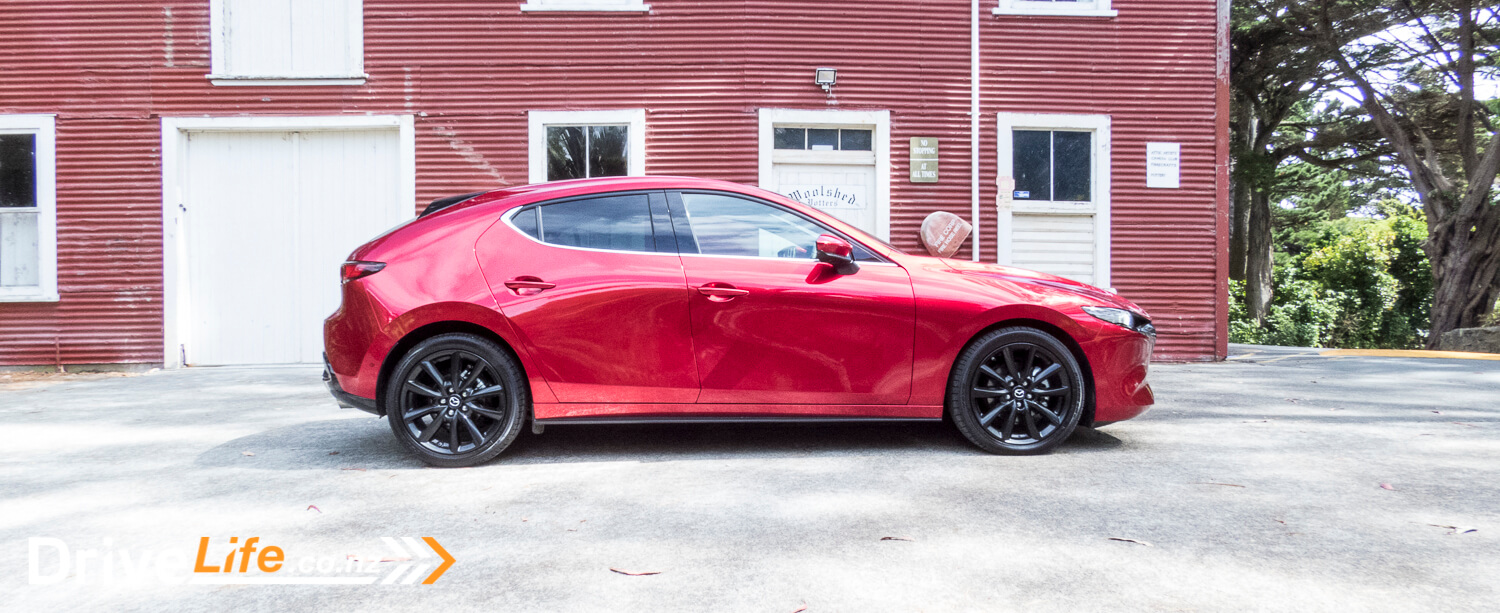
Then there’s the colour of our test vehicle.
All of us at DriveLife have different opinions, just as balanced individuals should. But, if there’s anything we’re unanimous on, it’s our opinion of Mazda’s Soul Red Crystal Metallic. This is easily one of the best reds you can find on a new mass market car today.
Overall, the stylish body and awesome paintwork makes the Mazda3 hatch look more bespoke and upscale. It looks less economy driven, less ‘copy and paste’, unlike other players in the hatchback market.
Go see one in the flesh, especially in red. I’d be surprised if you didn’t appreciate it.
What’s The Interior Like On The 2021 Mazda3 Takami?
Much like the exterior, Mazda has really brought out its A-game for the interior of the Mazda3.
When compared to the usual crop of Japanese hatchbacks, the Mazda3’s interior really delivers the wow-factor. The interior feels like it belongs in the entry-level luxury segment.
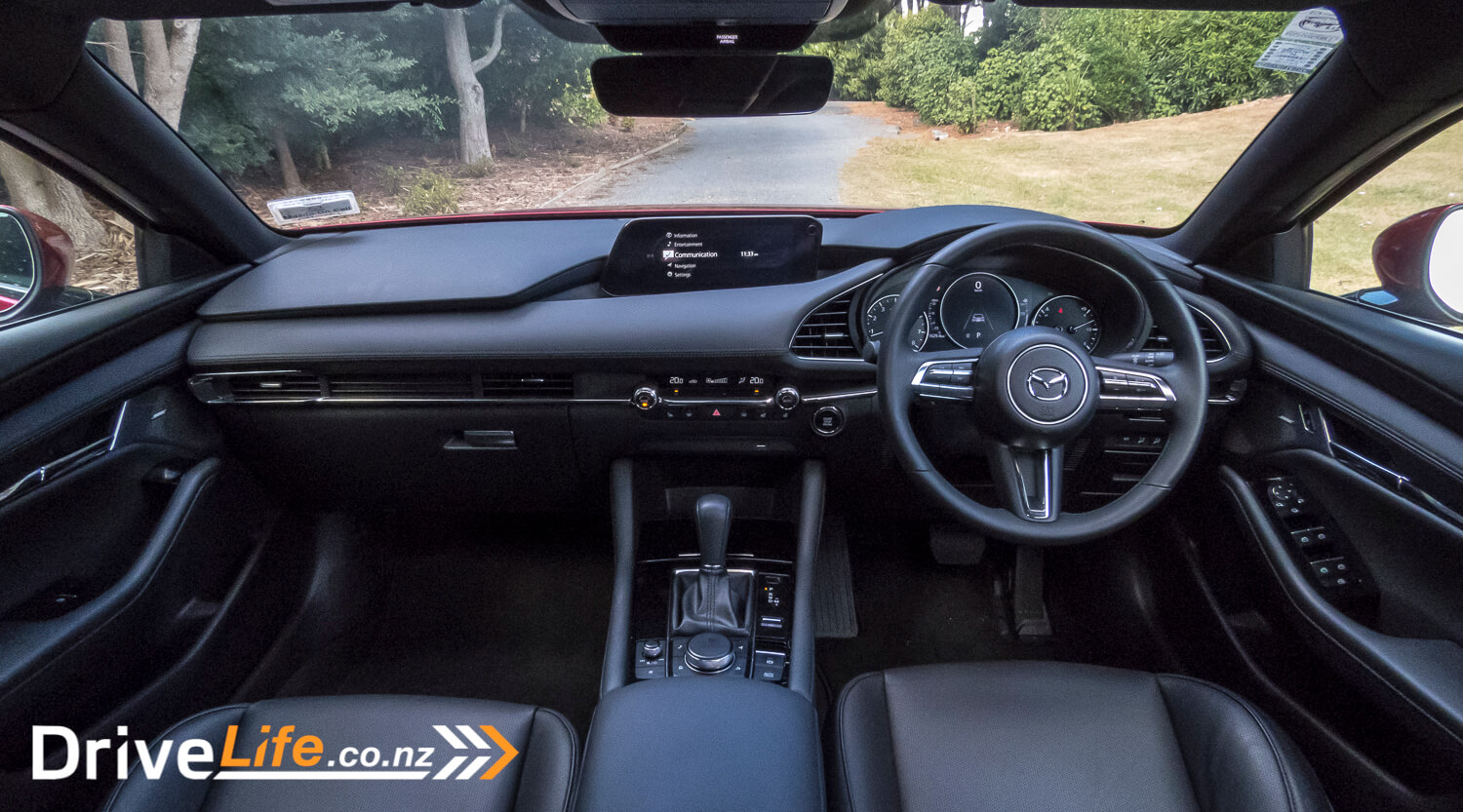
Stepping inside the cabin, you soon notice the abundant use of leather and soft-touch materials across the main surfaces and all the key touch points. The twin-level dashboard is wrapped with soft materials and is finished with brown contrast stitch. Recessed into the dashboard rests a landscape layout infotainment screen and below the dash is a minimalistic climate control cluster.
Adding to the feeling of luxury are many mechanical textures, demonstrated when you interact with the central command dials, through to the steering wheel switches and the climate control buttons. All the buttons feel tactile, and there’s little vagueness in any of the switchgear. These are small details to appreciate, yet they are often only given attention to in much more expensive vehicles.
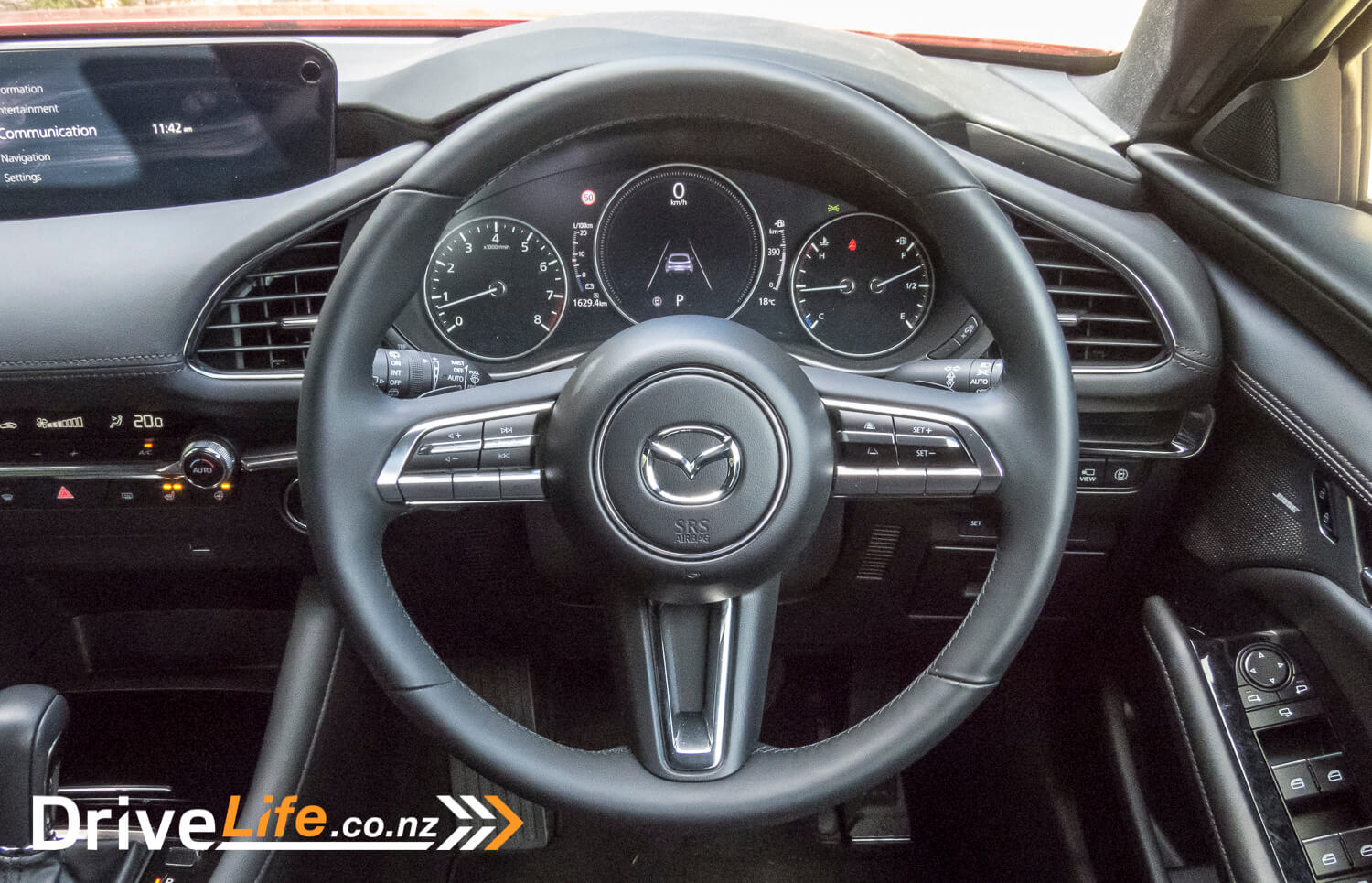
There are hard plastics inside the cabin, yet all of them are durable and most are hidden below the knee level. Altogether, Mazda has created an elegant and luxurious interior space, but it’s also incredibly straightforward to operate. Mazda has clearly devoted some resources to simplicity of design and to minimise driver distraction.
Mazda demonstrates this through decluttering; there’s relatively few buttons and the interior has clearly defined areas for certain vehicle controls.
This means you’ll only find climate controls with the climate controls. The dashboard only provides details related to driving the car and is not interrupted with unrelated details, like the song that’s playing or having a satnav screen taking up space.

This might sound like a fairly rudimentary thing for a car in the 21st century, but it’s becoming more common for the infotainment and dashboard to share functions. Also, with all the tech finding its way into modern cars, it’s becoming increasingly common to find controls pasted around the cabin in only loosely defined spaces. The simplicity of the layout means you’re far less likely to be distracted, and you will not be throwing your hands around the dash to find controls.
Mazda’s approach with the infotainment screen is a prime example of this. Mazda throws away the touch screen interface for one exclusively controlled by a rotary dial on the centre console. Centralising everything to a rotary dial reduces the variety of movements a driver needs to make on the fly.
This may sound like a step back in today’s modern age, but the reality is the complete opposite. Once you’re passed the initial learning curve of using the dial, you’ll find it wonderful to use. Personally, I did not miss having a touchscreen.
Furthermore, many touch interfaces featured in modern vehicles are nothing like your average smartphone. They’re much slower and clunkier, plus the user interfaces (UI) are a mixed bag too. It’s why many drivers use Android Auto and Apple CarPlay instead of the one provided.
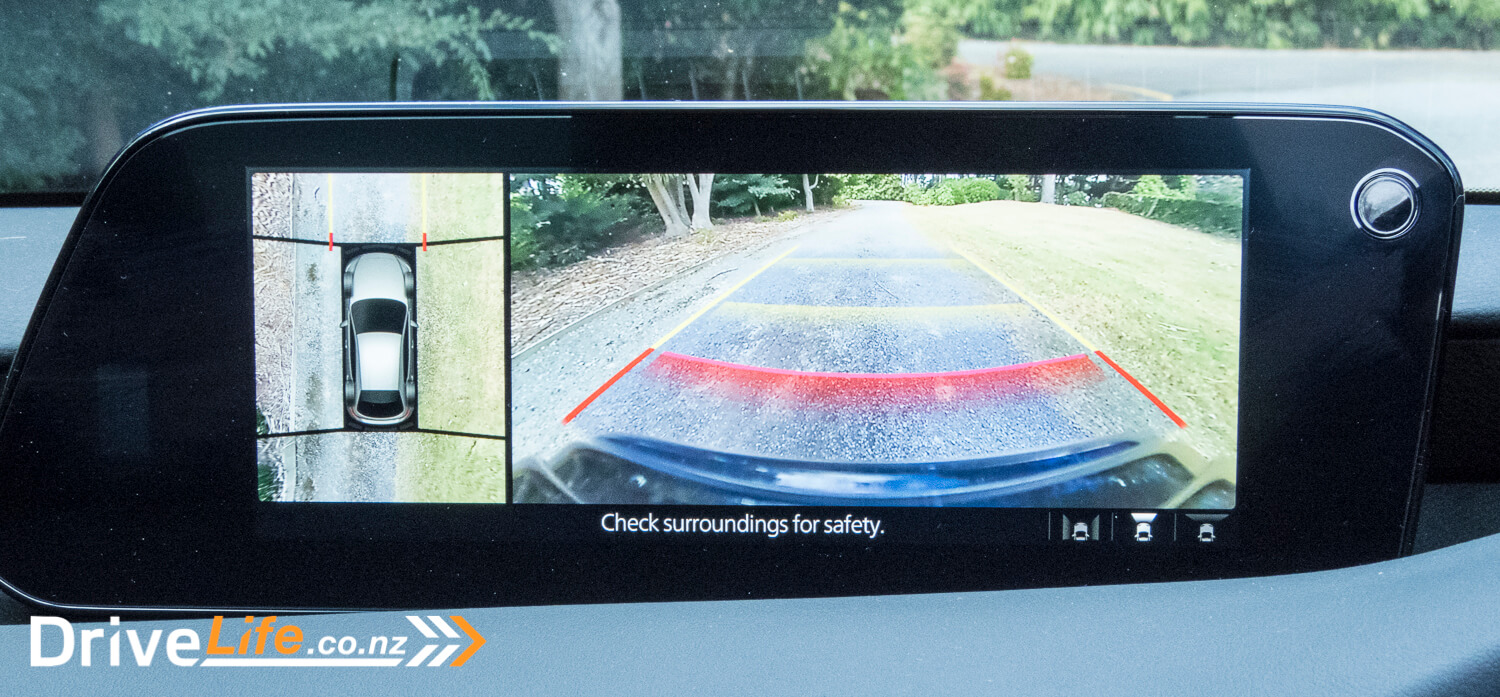
In Mazda’s case, their new UI for the infotainment is great. It’s simple to navigate and demonstrates virtually no lag between menus. Although Android Auto and Apple Carplay are available in the Mazda 3, it’s a better experience using Mazda’s own system.
The screen itself has great resolution, contrast ratios and black levels. The exterior front and rear cameras also have excellent resolution and refresh rate. Again, I’m only used to seeing something of this quality on a car with at least $10,000 added to the price tag.
In our Takami, the infotainment is connected up to an ace 12-speaker Bose Audio system. Before getting carried away with the speakers, it’s important to acknowledge that a car’s soundstage is a complicated space. Cars are full of glass, angles and other materials, which can interrupt a sound wave or create distortions and so on.
This means that more speakers do not necessarily mean better sound quality. In fact, there’s actually more complexity to manage when adding more speakers. It means more sound waves, and more finetuning to ensure everything sounds good.
Which brings us to the Bose system inside the Mazda 3. Beyond those stylish speaker stainless steel grilles is actually some well-considered sound engineering.
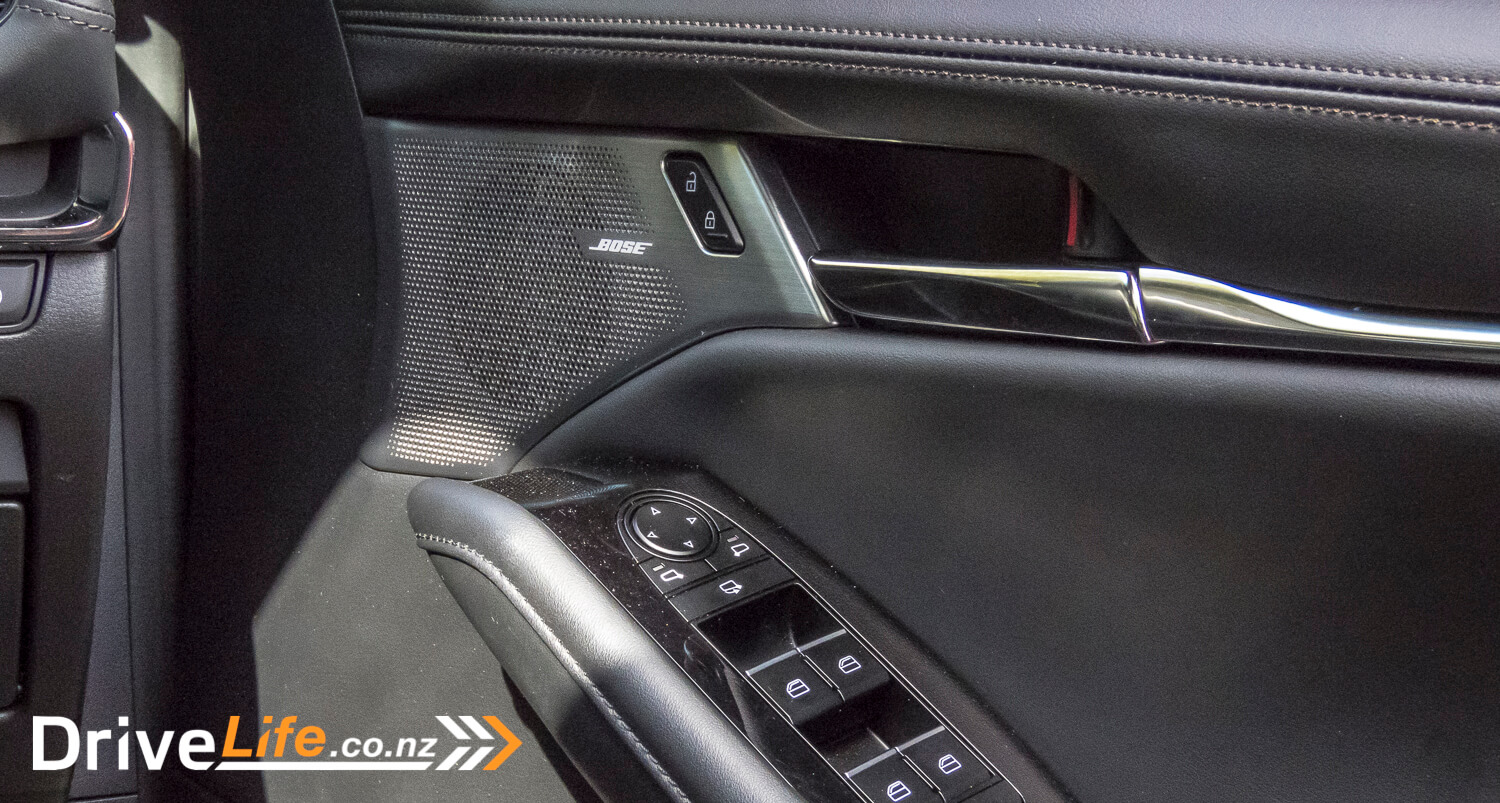
For example, those speakers located further up the door-card are the only ones you will find in the door. It’s redesigned to reduce NVH, which would arise from cutting in the base of the door. Footwell speakers are instead located down near your feet, attached to the body of the car. In the boot is a sizable subwoofer, mounted inside the spare wheel.
The result is a damn fine speaker system for the price. It’s a classic modern Bose system, which has a nice warm sound. It captures the highs well and lows decently too. There’s also plenty of bass which can be squeezed out, so the kids can enjoy their homogenised top 40 hits.
The dash cluster is also another example of Mazda’s attention to design. The cluster is a combination of digital and physical screens. In the centre is a digital screen, with three different displays, flanked by physical dials for fuel and temperature. When the digital screen is set to the speedometer, it fits in so convincingly with the physical ones that on a few occasions passengers ended up believing the entire thing was a physical cluster.
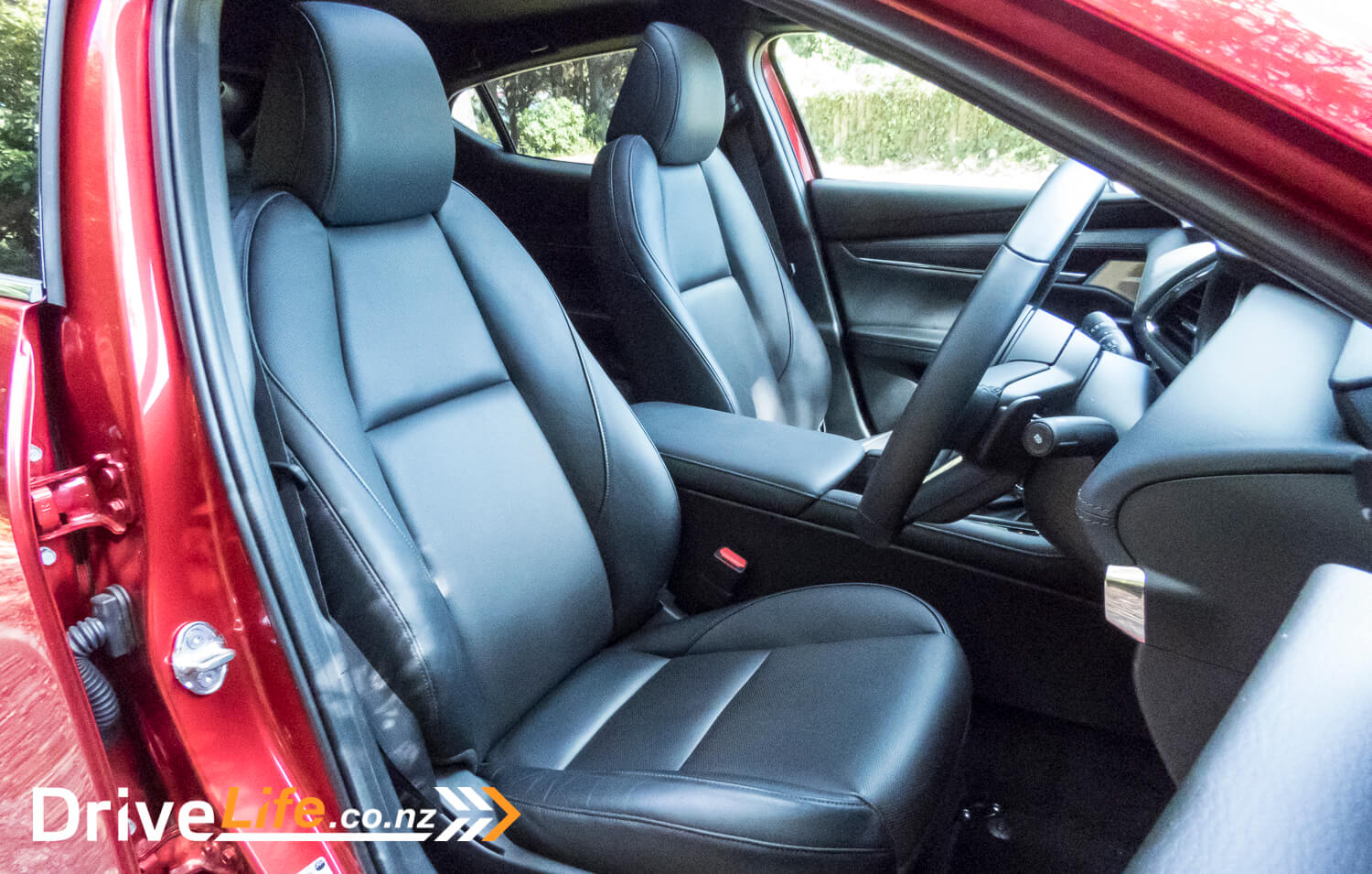
The front seats are firm, but exceptionally well supported. The Takami gives you power operation for the front, meaning you can set them exactly where you want them. The seats in this spec also wear black leather with brown perforation, which is another luxurious touch. The Takami also gives you a heated steering wheel too.
The rear space is the Mazda3’s weak point. Rear passenger leg and headroom is not what I call generous. There’s also a tunnel impeding on middle seat legroom too, meaning that this a four-adult car at best.
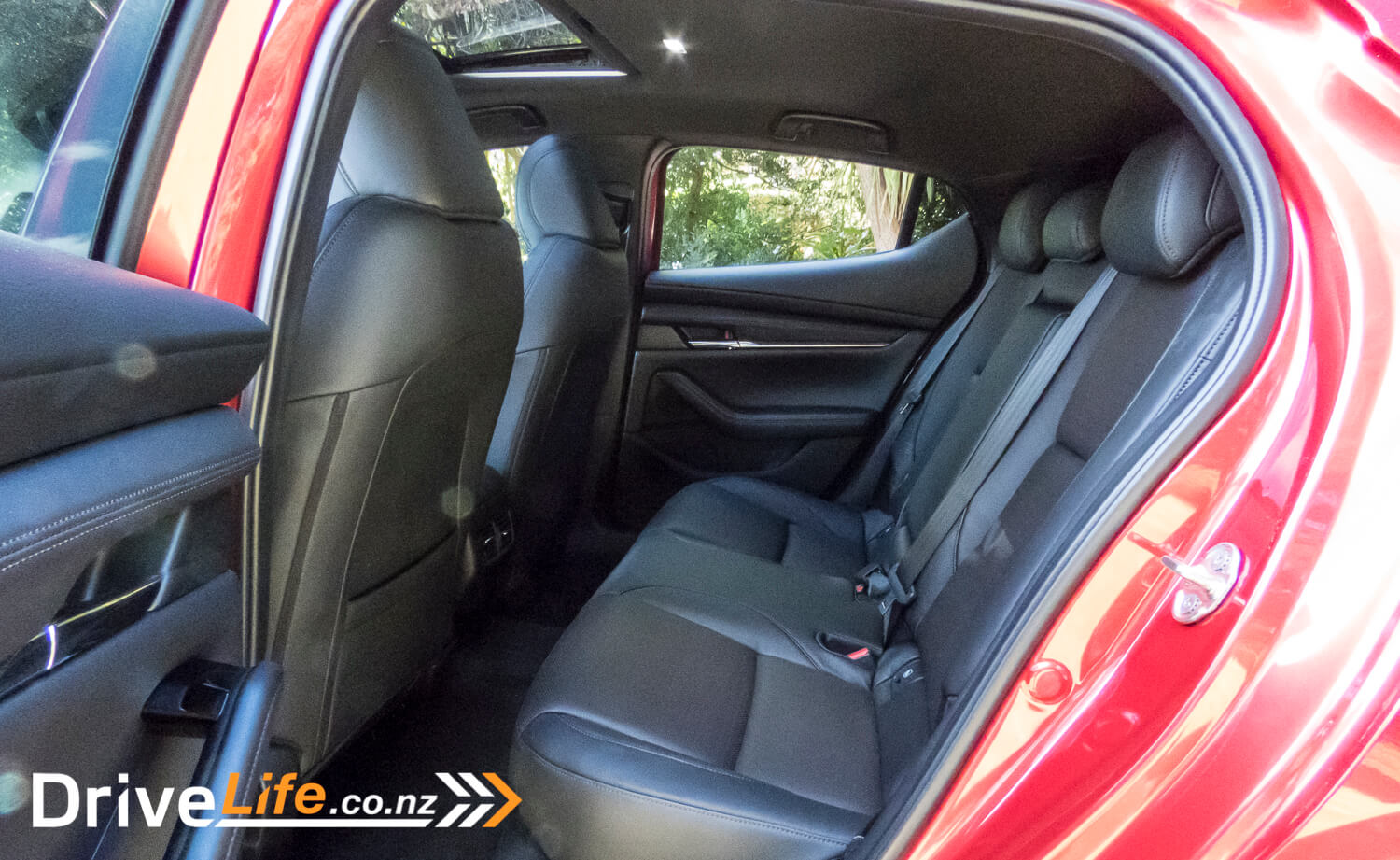
The sexy C-pillar design from the outside does introduce a fairly large blindspot in the rear, while also blocking out a good amount of light from getting into the back seats. Add to the fact that the entire rear is populated with black materials, those occupying the backseats will find they have a rather dark and pokey space to get comfortable in.
Here, I believe Mazda could help the situation with a larger panoramic sunroof to allow more light inside. The current sunroof only serves the front passengers well.
Fortunately, getting comfortable can be done. But I’d recommend a few more pie stops for the sake of the rear passengers on longer trips.
There are two final irritations with the Mazda3’s interior.
Mazda has redesigned the centre console to give the driver and passenger a large leather armrest atop the centre console. The lid to the centre console is designed to slide back before opening upwards, which is great for those in the front seats. However, the hinge will whack into the knees of any passenger that sits in the centre rear seat. Again, another reason rear passengers mightn’t think as highly of the 3 from the back.
The next complaint is a minor one, and relates to the only odd button placement in the cabin.
The button for the heated steering wheel is part of the same cluster as the climate controls, but tacked right on the end. The climate control knob obscures the button (and the light telling you it’s active) from the view of the driver. I found myself leaning forward to see it from a different angle, to ensure you’d remembered to switch it on.
Overall, Mazda has created an interior space which is sparring with the interiors offered in considerably more expensive cars. It’s undoubtedly a huge step-up over previous Mazda3 models, and I do genuinely think that anyone who steps into this will be blown away by the quality for the price level.
If I were to add my own personal touches, I’d do a larger, panoramic sunroof and add a wireless phone charger. Adding these would really frighten the Germans, especially those with thousands added to the price tag.
What Does The 2021 Mazda3 Takami Drive Like?
With all the attention and praise directed towards the interior, a cynical buyer might start to believe that the driving experience will be nothing more special than that of the competition. They’d be wrong.
The Mazda3 has typically been a decent car to drive, yet the Mazda3 Takami brings another level of engineering into the equation. The showpiece is Mazda’s newly developed engine architecture, which they call Skyactiv-X. This engine utilises a process called Spark Control Compression Ignition (SPCCI).
…a what now?
We’re about to get a bit technical here, but essentially, it’s a petrol engine which can behave like a diesel.
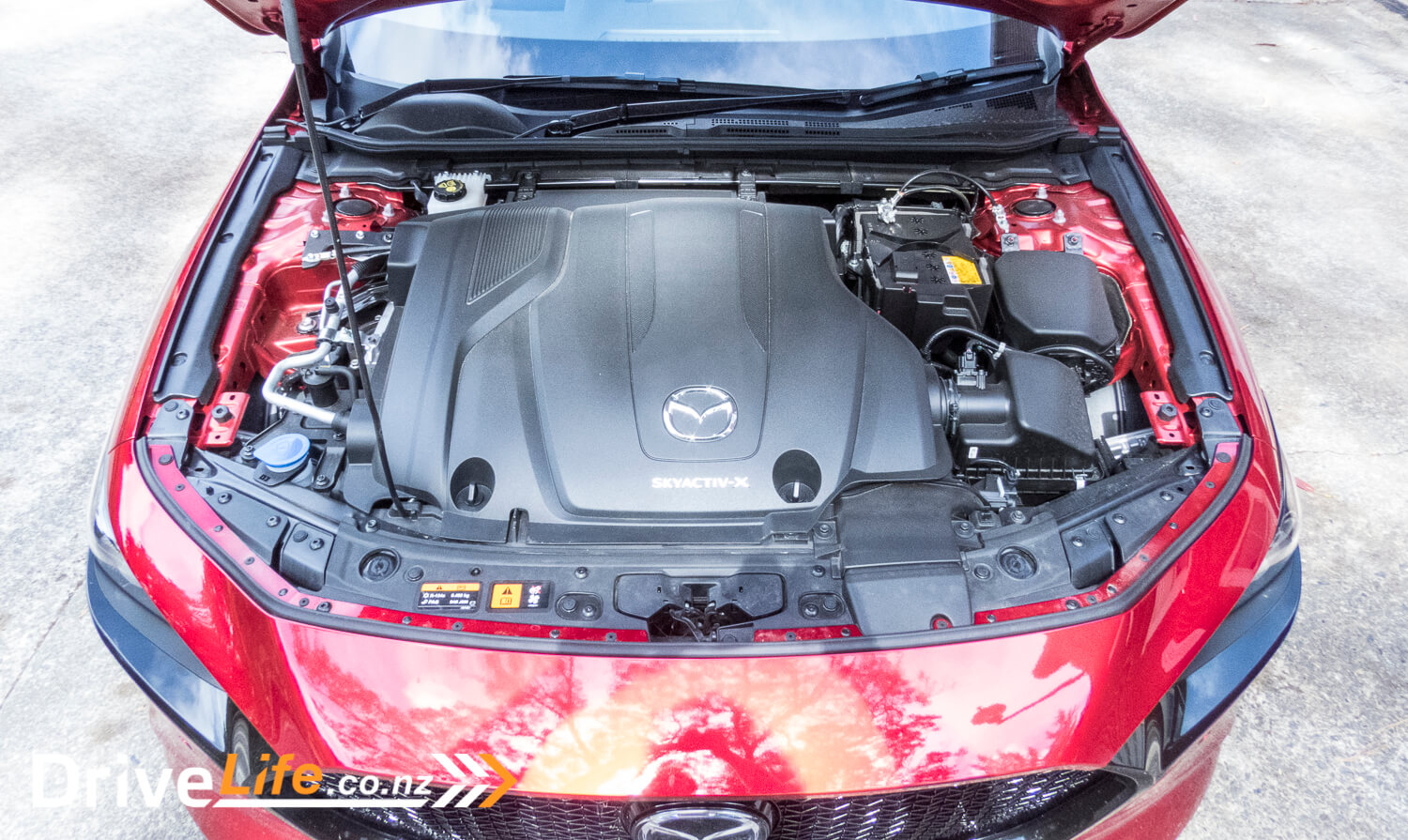
In a petrol vehicle, the fuel/air mixture in the cylinder is ignited with the spark plug. Diesel vehicles do not use spark plugs, as the fuel/air mixture is already volatile enough to combust under compression without the need for a spark, i.e. compression ignition.
The Skyactive-X is designed so that the engine can swap between either spark ignition or compression ignition, based upon what the vehicle deems to be optimal. The engine even uses a tiny ‘supercharger’ to help squeeze more air into the cylinder to assist with this combustion process.
Okay, so why go to the trouble of all this?
Well, it allows for a bigger bang from a leaner fuel-air mixture, which lowers CO2 emissions, saves you money on petrol, and even reduces NOx nasties from a more efficient burn. Adding to the SPCCI process, the engine also operates a very high compression ratio (16.3:1), and the greater the compression ratio, the better the thermal efficiency, ergo better gas mileage.
While achieving all this, the Skyactiv-X will behave like a normal petrol engine, being free-revving and without sounding like a diesel.
Sounds great! So, what’s the result of all of this engineering?
As alluded to, the first notable benefit is fuel economy. Mazda claims a combined fuel consumption figure of 5.5L/100kms. In our own test, I didn’t notice any huge improvements driving around town, though motorway driving saw the real results. On the motorway, it was easy to get fuel consumption well into the low 6L/100Km range without really trying. I’m sure that a dedicated driver would have no troubles breaching the 5L/100Km mark.
Overall, we achieved an average fuel economy result of 6.8L/100Kms during our time with the Mazda 3. This is a fairly good real-world result by many standards for a 2.0L engine.
Another factor to be aware of when selecting the Takami is that it’s the only Mazda3 within the line-up which recommends the use of 95 Octane. Other Mazda3 models can get away with running 91 Octane. This does mean your overall fuel savings will be determined by the price differential at the pump, which in some areas could be a bit of a deal breaker.
However, the Mazda3 redeems itself on emissions. The Mazda3 SkyActiv-X achieves an emissions result of 126g of CO2 per km. For perspective, a petrol-powered Toyota Corolla or Honda Civic produces 138g of CO2 per km, a figure which can add up over years of ownership.
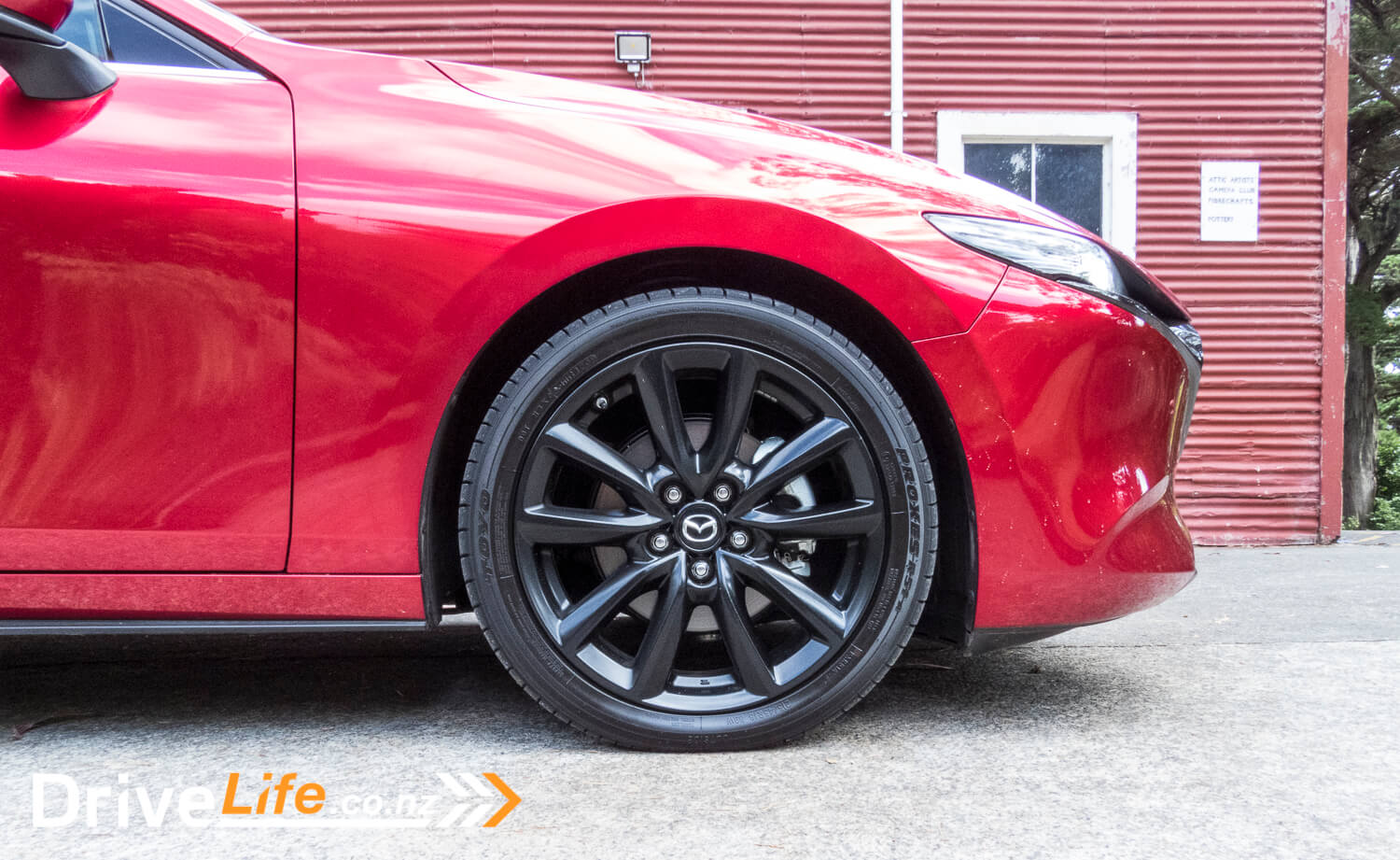
With all the attention on emissions, the next strength of the SkyActiv-X is less discussed, and that is refinement.
This engine is exceptionally refined and incredibly quiet for an engine without direct electric assistance. When I was photographing the car, there were times where you’d second guess yourself whether you’d turned off the car, when you had indeed left the engine running.
You’ll seldom hear the engine driving along either, which has an unintended consequence of the driver noticing a fair amount of tyre noise. I wouldn’t call the noise excessive, as the cabin is decently insulated, but you do indeed notice it.
The Mazda3’s ride quality is also impressive, especially given that the car uses a torsion beam rear. The Mazda3 also utilises Mazda’s excellent G-Vectoring Control (GVC), which is effectively a torque vectoring system. It’s designed to help the driver corner smoothly, by adjusting torque upon entry to a corner. The outcome is a car which corners neatly and manages body roll well.
Don’t expect to be feeling any of these intricacies as you potter along, as the steering feel is fairly numb in the Mazda 3, but you will be satisfied with its weight.
How about engine performance? The 2.0L SkyActiv-X in the Mazda3 produces 132kW of power and 224Nm of torque. Ultimately, it’s an engine designed for efficiency, so don’t go expecting anything that will blow you away off the line.
Overall, the engine is reasonably healthy through the mid-range, but otherwise low-end torque feels slightly lacking. This means there’s no real performance shove as you move off the line.
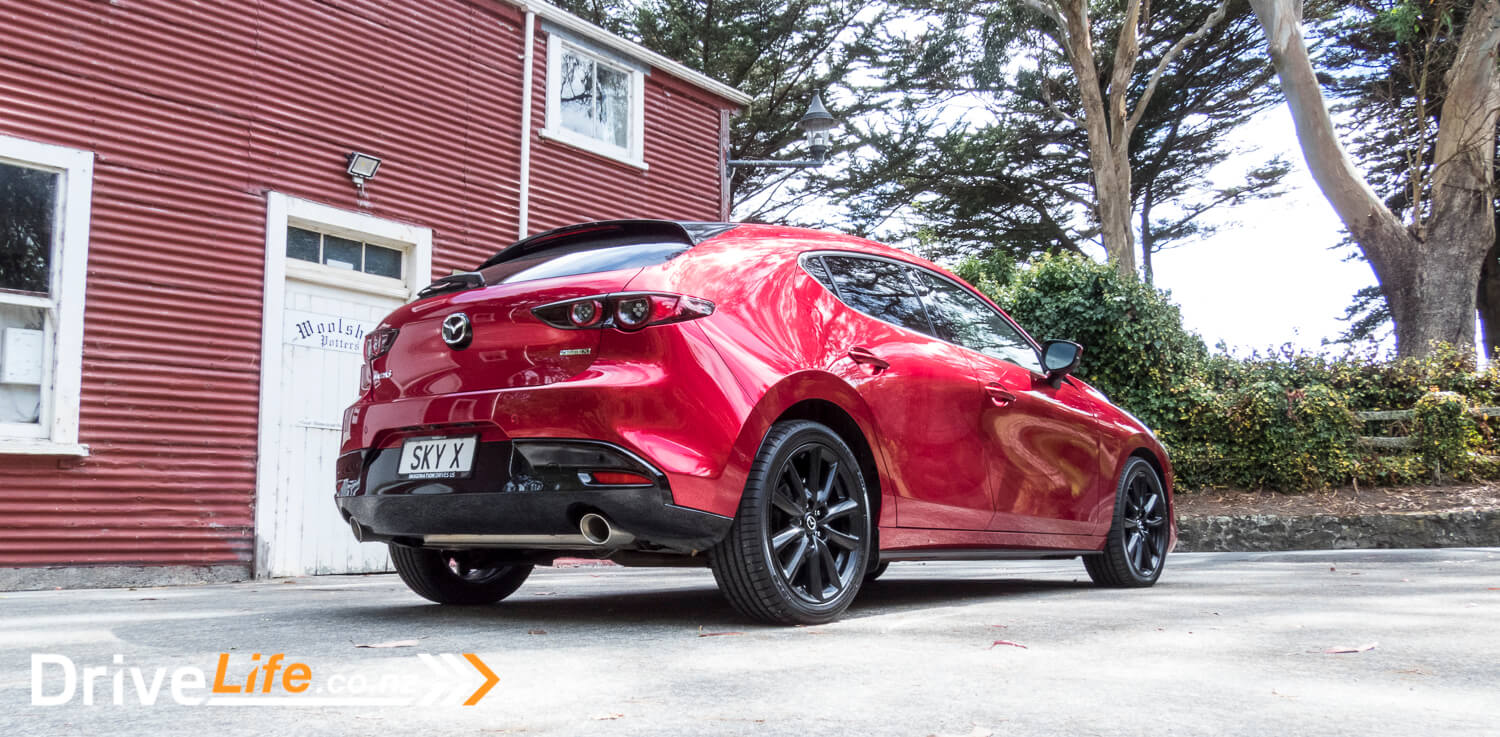
One quirk is the accelerator pedal, which feels firm compared with other hatchbacks. This is not necessarily a bad thing, but it is a learning curve for piloting the Mazda3. Also, similar to the CX-30, the brake pedal also doesn’t have the most reassuring initial bite, but the brakes are perfectly satisfactory where it counts.
With respect to driver’s tech, the driver assistance in the Mazda3 is mostly non-invasive, with relatively few quirks.
Mazda has incorporated a pleasant chime for when the safety systems activate, such as the Blind Spot Detection and the Rear Cross Traffic alert. Again, it’s another one of those attention to detail qualities, which is far more pleasant than an abrupt beep. It also makes all the safety gear much nicer to live with, given that these systems often detect false positives (which every car does).
Also, the radar cruise control operates effectively and is capable of stop/start from a halt, which is to be expected from this price point.
The only major quirk with the safety technology was with Mazda’s Lane Centering Assist, mainly because you are seldom ever able to use it. The system never wanted to activate on the motorway, which is generally the area where this technology works best. The only circumstances where I found it could be reliably used was in slower, main road conditions, or in a highway traffic-jam.
Traffic sign recognition also had a mind of its own at times, occasionally generating a speed limit that was entirely incorrect.
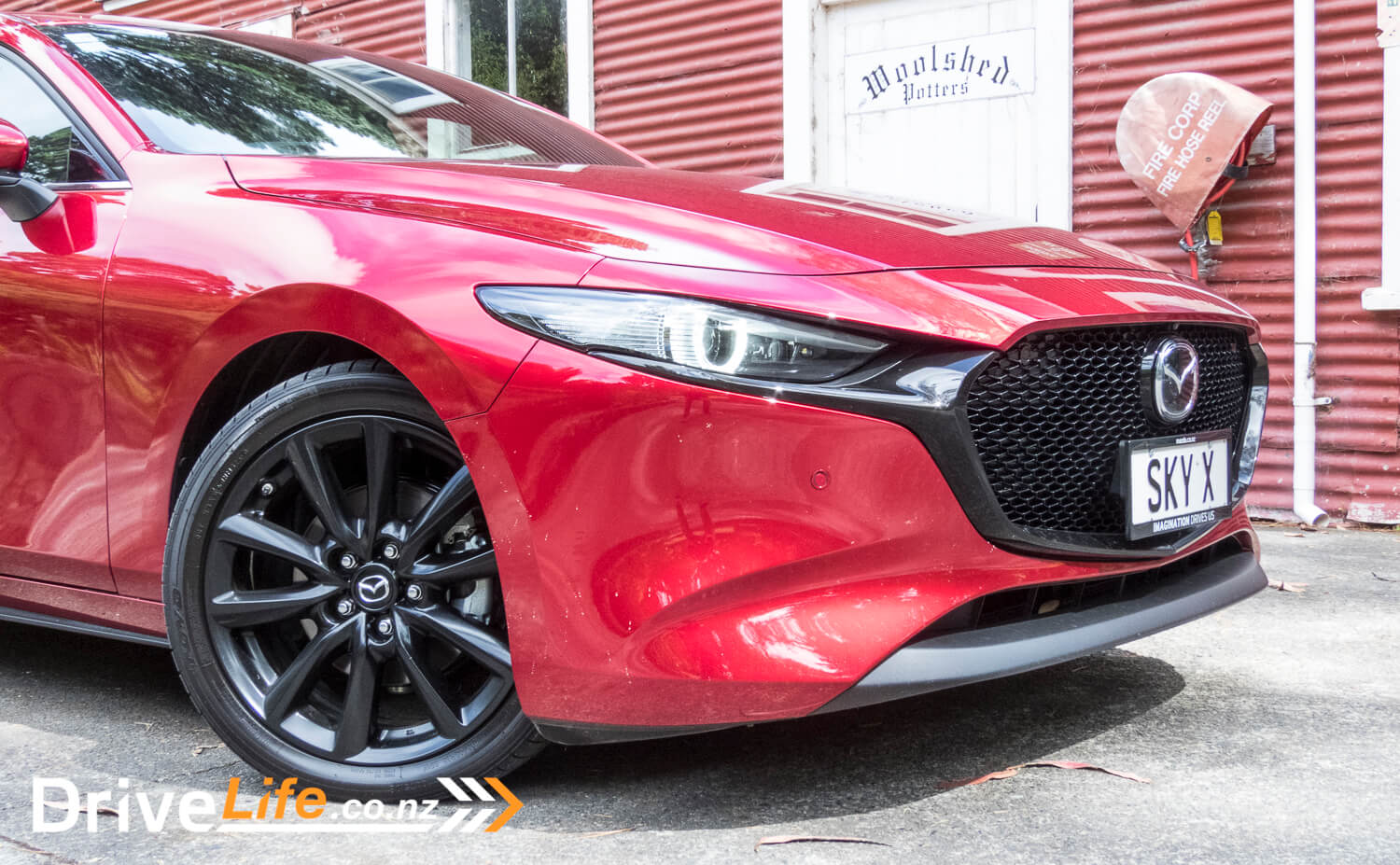
The Competition
| Brand/Model | Engine | Power(kW) Torque (Nm) | Fuel, L/100km (claimed) | Boot Space Litres | Price |
| Audi A3 35 TFSI Advanced | 1.4 litre 4-cylinder turbo | 110/250 | 5.0 | 380 | $57,990 |
| Mercedes A180 | 1.3 litre 4-cylinder turbo | 100/200 | 5.7 | – | $56,200 |
| Mini Cooper S 5-Door | 2-litre 4-cylinder turbo | 141/280 | 5.8 | 278 | $55,000 |
| Mazda3 Takami | 2-litre 4-cylinder | 132/224 | 5.5 | 295 | $51,995 |
| Lexus CT200h | 1.8 4-cylinder hybrid | 140/240 | 7.4 | 522 | $51,700 |
| BMW 118i Sports Line | 1.5 litre 3-cylinder turbo | 103/220 | 6.0 | 380 | $49,990 |
| Volkswagen Golf R-line | 1.4 litre 4-cylinder turbo | 110/250 | 5.8 | 381 | $47,990 |
| Ford Focus ST-Line | 1.5 litre 3-cylinder turbo | 134/240 | 6.4 | 443 | $42,990 |
| Honda Civic RS | 1.5 litre 4-cylinder turbo | 127/220 | 6.4 | 340 | $41,990 |
| Toyota Corolla ZR | 2-litre 4-cylinder | 125/200 | 6.0 | 208 | $38,690 |
| Mazda3 GSX | 2-litre 4-cylinder | 114/200 | 6.2 | 295 | $36,895 |
Pros And Cons Of The 2021 Mazda3 Takami
Pros
- Exterior styling
- Interior quality and design
- Engine refinement
- Trick compression ignition engineering (SPCCI)
- Ride quality
Cons
- Cramped rear interior space
- Questionable real-world fuel savings
- Seldom usable lane centering assist
- Traffic sign recognition sometimes has a mind of its own

2021 Mazda3 Takami – Specifications
| Price as Tested | $51,995 |
| Engine | 2-litre 4-cylinder SkyActive X engine with mild hybrid system |
| Power, Torque kW/Nm | 132kW @ 6,000rpm 224Nm @ 3,000rpm |
| Transmission | 6-speed automatic transmission |
| Spare Wheel | Space saver |
| Kerb Weight, Kg | 1,436 |
| Length x Width x Height, mm | 4460 x 1795 x 1435 |
| Cargo Capacity, litres | 295 (rear seats up) |
| Fuel capacity, litres | 51 |
| Fuel Type | 95 Unleaded Petrol |
| Fuel Efficiency | Advertised Spec – combined – 5.5L/100km Real World Test – combined – 6.9L/100km Low Usage: 0-6 / Medium Usage 6-12 / High Usage 12+ |
| Towing Capacity Kg, unbraked/braked | 600/1200 |
| Turning circle, metres | 10.6 Small: 6-10m / Medium 10-12m / Large 12m+ |
| Warranty | 3-year/unlimited kilometre comprehensive new vehicle warranty 5-year/unlimited kilometre major component and safety system warranty 5-year/unlimited kilometre corrosion and anti-perforation warranty |
| ANCAP Safety Ratings | 5 Star |


